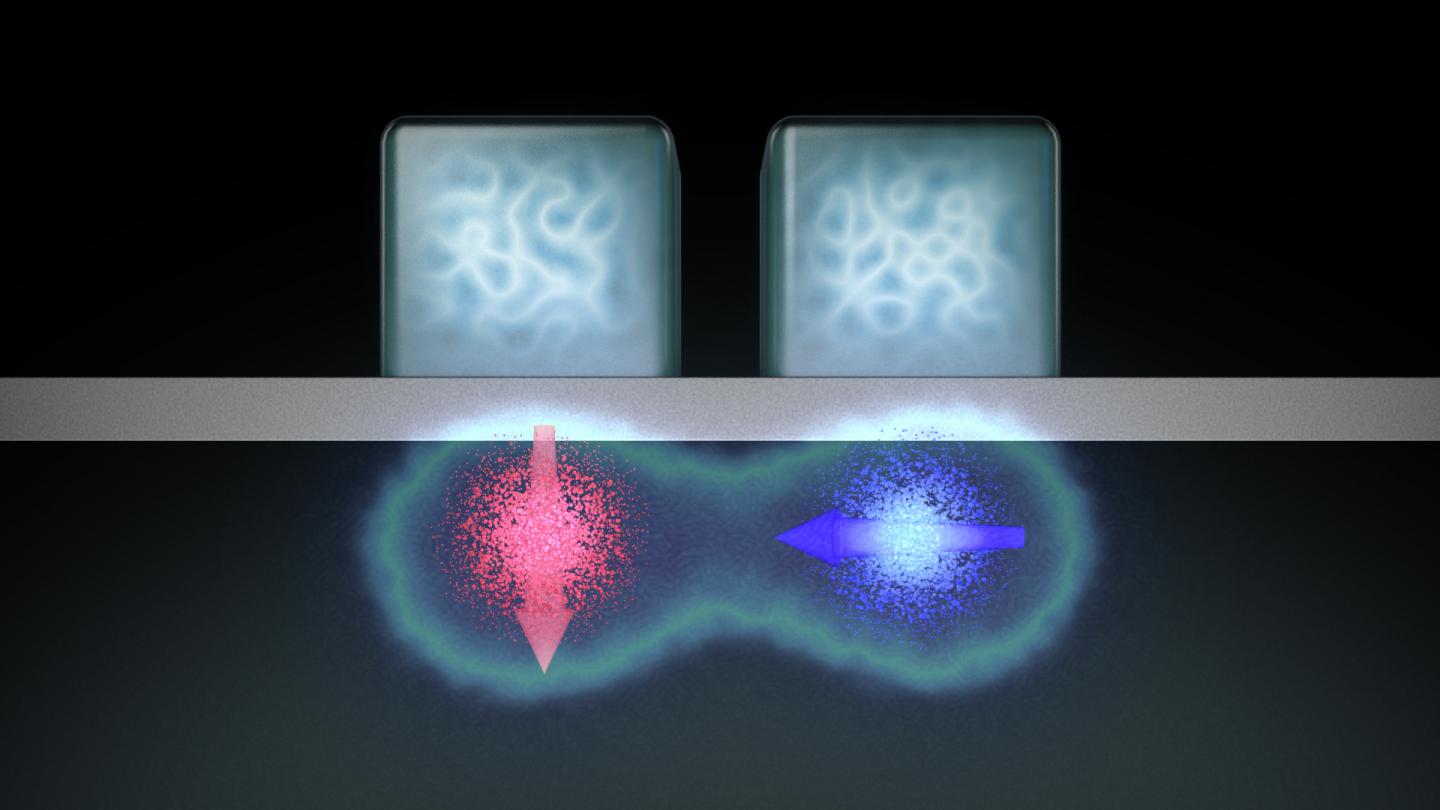First two-qubit logic gate built in silicon
October 5, 2015

Artist’s impression of the two-qubit logic gate device developed at UNSW. Each of the two electron qubits (red and blue) has a spin, or magnetic field, indicated by the arrow directions. Metal electrodes on the surface are used to manipulate the qubits, which interact to create an entangled quantum state. (credit: Tony Melov/UNSW)
University of New South Wales (UNSW) and Keio University engineers have built the first quantum logic gate in silicon, making calculations between two qubits* of information possible and clearing the final hurdle to making silicon quantum computers a reality.
The significant advance appears today (Oct. 5, 2015) in the journal Nature.
“What we have is a game changer,” said team leader Andrew Dzurak, Scientia Professor and Director of the Australian National Fabrication Facility at UNSW. “Because we use essentially the same device technology as existing computer chips, we believe it will be much easier to manufacture a full-scale processor chip than for any of the leading designs, which rely on more exotic technologies.”
University of New South Wales
“If quantum computers are to become a reality, the ability to conduct one- and two-qubits calculations are essential,” said Dzurak, who jointly led the team in 2012 that demonstrated the first ever silicon qubit, also reported in Nature.
Until now, using silicon, it had not been possible to make two quantum bits “talk” to each other and thereby create a logic gate. The new result means that all of the physical building blocks for a silicon-based quantum computer have now been successfully constructed, allowing engineers to finally begin the task of designing and building a functioning quantum computer, the researchers say.
Dzurak noted that the team had recently “patented a design for a full-scale quantum computer chip that would allow for millions of our qubits … using standard industrial manufacturing techniques to build the world’s first quantum processor chip. … That has major implications for the finance, security, and healthcare sectors.”
He said that a key next step for the project is to identify the right industry partners to work with to manufacture the full-scale quantum processor chip.
Dzurak’s research is supported by the Australian Research Council via the Centre of Excellence for Quantum Computation and Communication Technology, the U.S. Army Research Office, the State Government of New South Wales in Australia, the Commonwealth Bank of Australia, and the University of New South Wales. Veldhorst acknowledges support from the Netherlands Organisation for Scientific Research. The quantum logic devices were constructed at the Australian National Fabrication Facility, which is supported by the federal government’s National Collaborative Research Infrastructure Strategy (NCRIS).
* In classical computers, data is rendered as binary bits, which are always in one of two states: 0 or 1. A quantum bit (or ‘qubit’) can exist in both of these states at once, a condition known as a superposition. A qubit operation exploits this quantum weirdness by allowing many computations to be performed in parallel (a two-qubit system performs the operation on 4 values, a three-qubit system on 8, and so on).
Abstract of A two-qubit logic gate in silicon
Quantum computation requires qubits that can be coupled in a scalable manner, together with universal and high-fidelity one- and two-qubit logic gates. Many physical realizations of qubits exist, including single photons, trapped ions, superconducting circuits, single defects or atoms in diamond and silicon, and semiconductor quantum dots, with single-qubit fidelities that exceed the stringent thresholds required for fault-tolerant quantum computing. Despite this, high-fidelity two-qubit gates in the solid state that can be manufactured using standard lithographic techniques have so far been limited to superconducting qubits, owing to the difficulties of coupling qubits and dephasing in semiconductor systems. Here we present a two-qubit logic gate, which uses single spins in isotopically enriched silicon and is realized by performing single- and two-qubit operations in a quantum dot system using the exchange interaction, as envisaged in the Loss–DiVincenzo proposal. We realize CNOT gates via controlled-phase operations combined with single-qubit operations. Direct gate-voltage control provides single-qubit addressability, together with a switchable exchange interaction that is used in the two-qubit controlled-phase gate. By independently reading out both qubits, we measure clear anticorrelations in the two-spin probabilities of the CNOT gate.